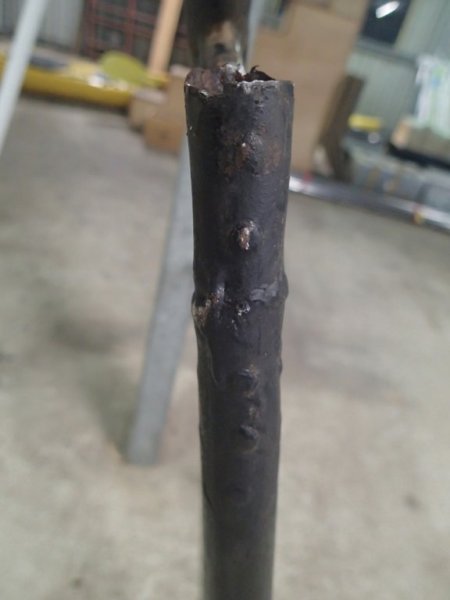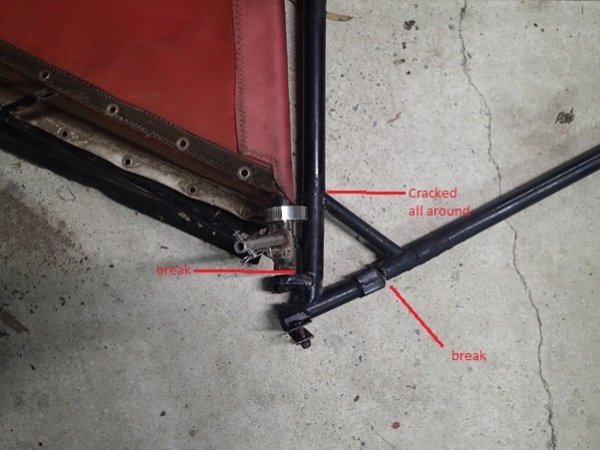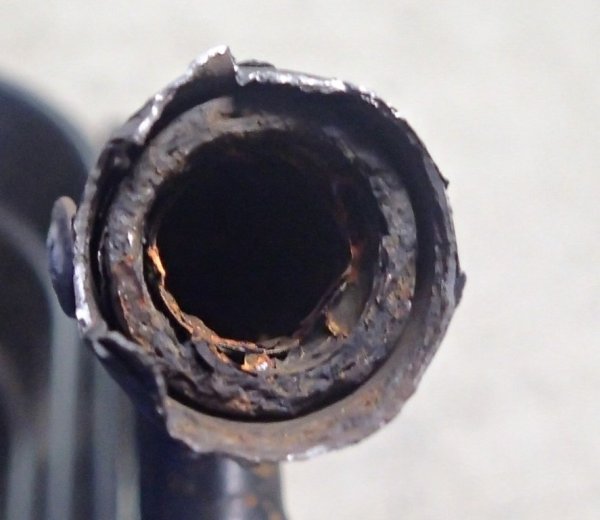-
Posts
25 -
Joined
-
Last visited
Content Type
Profiles
Forums
Gallery
Downloads
Blogs
Events
Store
Aircraft
Resources
Tutorials
Articles
Classifieds
Movies
Books
Community Map
Quizzes
Videos Directory
Everything posted by craigL
-
Hi Mac I have a T500 for sale in Southern Queensland. I have PMed more details to you - see your messages/conversations (envelope sign in upper left). cheers Craig
-
I like the aircraft, but am at a bit of a loss as to how to go forward, especially since it's 25-xxxx registered ...
-
No, I don't blame anyone. I believe the fault was invisible to the seller, the L2, and myself, but caution others to be aware of this possibility.
-
Your pictures haven't come through though, they may need resizing to get them to download. Have been struggling with it. Do these work?: DamageLocations Corrosion Welding
-
This is an accident report of a failure to a Thruster T500 with registration 25-0780. The fault occurred around 1100 on 22 July 2017 i the Lockyer Valley, QLD. It was reported to both ATSB and RAAus. The flight was a training flight with the instructor as pilot in command (very experienced) and myself as the student. We taxied the aircraft several hundred meters to the end of the airfield and I snaked the path a bit by rudder to practice rudder control while taxiing. At this point the rudder was functioning OK. Then we increased the throttle and the aircraft accelerated. When it left the ground, however, it veered widely to the left and then to the right and we could not control it. LOC-I. Hence we cut the power and were fortunate that it landed softly, right way up and without collision with terrain or trees before the end of the runway. We had only reached a height of somewhere between 10 and 20 feet. I tried to steer it around to taxi back to the start of the runway, but found that there was no right rudder control, and the attitude was high. We stopped the aircraft and got out to discover three structural faulures at the base of the rear tail strut. This had prevented use of the rudder to control the aircraft, and the tail wheel, which was also structurally supported under the broken piece, but now hung sideways dragging on the ground and supported by its side springs. There were three failures. Two lower breaks separated the rudder support. The higher break was fully detached but held in place by an inner metal sleeve, since it no longer held anything. Both the higher break and the inner break to the right were fresh and the metal had normal colour. However, the break above the rudder cap occurred in highly corroded and paper thin metal. This was not visible before the break because it was painted over. The following picture shows the sites of the failures. With the broken piece gone, there was nothing to support the bottom of the base strut of the rudder, so the rudder ceased to work. Since the rudder was working during taxiing, this suggests that the break occurred during the takeoff run. Detail showing the highly corroded strut at top. This sleeve and a lot of rough welding on the structure shows rather poor quality repair work. The aircraft maintenance records show that it was wrecked and rebuilt in 1994. More detail of bad welding on old repair work: Much of this was hidden by the skins and the inner corrosion was invisible. The failure occurred on the second day of flying the aircraft after I bought it. It had been L2 assessed as being OK and a "great little aircraft". The seller flew it to the L2 and back, so I assume that he was either unaware of the corrosion or not concerned about dying. I'm posting this to encourage others to be extremely cautious about buying second hand aircraft and to raise awareness of possible faults that may be invisible to the eye and not noticed by maintenance certified inspectors. Best regards, good will flying, and may the powers that be have mercy on our frail hides ... as they had for W. and I on this occasion ! Craig
-
Hello Does anyone know of, or have any suggestions for, or is it possible, to get replacement parts for a Thuster T500? In particular, enpennage? Factory parts would be ideal, but there seems to be no factory any more. I have the original parts and need to consider taking them to a professional engineering company to have them rebuilt, but is there any more original or better source for this work? thanks and BR Craig
-
Quite a lot of these projects around these days. See: EHANG|Official Site-EHANG 184 autonomous aerial vehicle and This MegaDrone Will Be a Self-Flying Air Taxi in Dubai This Summer Biggest barrier is lack of regulations. Technology is fast getting there, or is already there.
-

Sad news, Plane crashes near Renmark
craigL replied to scre80's topic in Aircraft Incidents and Accidents
Very sad and a great loss. Wouldn't the emergency beacon have to be turned on before impact? If so, with such experienced pilots this suggests a technical failure or unrecoverable state as suggested above. I know it can be bad to speculate like this, but we all have skin in the game and ATSB can take so long to reach and release their conclusions. Understandable why, but meanwhile ... -

AOPA calls on CASA for private pilot medical reform
craigL replied to a topic in AUS/NZ General Discussion
I passed the Class 2 AVMED and during the examination the DAME told me that the average or typical systolic blood pressure for a 50 year walking in off the street is 150. He might have been exaggerating a bit, but there is an overall trending increase with age. People also frequently have an increase of10 points or more just due to entering a DAME's practice. So it's a good idea to record your blood pressure at home for a month or two before going in and show the record to the DAME. Also, if it's high, see a GP well beforehand so you can get it medicated before the DAME examination, otherwise you'll only be starting treatment at that point and it will greatly delay the process. I had to go through this because there were no local RAAus trainers and GA was the only option. Now moving to Brisbane where there are plenty of RAAus trainers, I'm sure if I'll do it again unless CASA can show some concrete empirical data justifying the need. There is a general problem in Australia of far too much bureaucracy and emphasis upon regulation and compliance. At the same time in CASA's case, reductions of staff mean increasing regulations with less people to implement them and it feels like the whole system is in danger of grinding to a halt. The greater problem is that bureaucracy becomes an end in itself - bureaucrats achieve success by having more junior bureaucrats under them, which is achieved by increasing rules and regulations that need more people to refine and implement them. If the regulations increase but the staff do not, then everything slows down and the life gets sucked out of us. This is really endemic in our culture these days. We need to return to a culture where people take responsibility for their own behaviour and can choose their levels of risk based upon good information. Bureaucracy is about control and limiting our freedoms, including our choices of risks that we accept or not. CASA should focus on information and minimise regulation. -
Fully agree! Electric aircraft will be a disruptive technology and it will be very interesting to see how the regulators (including RAAus) react to them. Aircraft with many electric props are already emerging, some like drones but human scale. E.g.: Volocopter I VC200 Prototyp and Joby S2 | Joby Aviation The many engines make them much safer than even twin props.
-
Re high vis, it's a cheap and easy way of making a strong but superficial visual statement that you are taking safety seriously. Most accidents happen once you're in the aircraft, when high vis is totally irrelevant. And most are due to pilot error or engine failure. What would be much more useful would be better quantitative studies of safety factors. E.g. statistics on accident types by aircraft model, engine type, correlations with initial training location, conditions, etc., which are unavailable in a high level form (you can only get raw accident data, which would take an impossible amount of time to compile statistics from). This could be done by making the data accessible on line for high level complex database queries so conclusions could be crowd sourced from the data.
-
I'll be there and travelling from Tassie for it. Haven't been to an Avalon show before, really looking forward to it - there will be lots of GA and Sport aircraft on display. Don't have time for the trade days though.
-
This is a very old thread but I couldn't resist pointing out the incongruity of the requirement to use the ERSA info on-line only. The documents are in .pdf format, so to use them you need to click the link, which automatically initiates download of the .pdf before the reader can open it for reading. So it's actually not possible to use 'on-line only', and everyone has a copy on their local computer (e.g. in the Downloads directory).
-
The CASA material is pretty complicated by all of the cross references to different parts of the regulations. But there's a good summary of the categories in the current issue (Jan/March 2017) of Aero Australia magazine.
-
I'm also in training and starting to approach 20 hours without soloing. This bothered me for a while, after hearing of much shorter periods for other people, but I don't care any more. I've also had a lot of instructor changes, in one sequence having 3 different instructors in three consecutive lessons. The reason for this has been needing to fly at specific times due to work commitments that has meant at times not matching the instructor rosters for having the same instructor all the time. I do feel that learning a specific way of flying would progress more quickly staying with one instructor. This is partly because when you change to someone you haven't flown with before or for a while, they are likely to want you to do vanilla circuits so they can tell where you are up to. This can feel like taking a step backwards. One time this happened I felt quite annoyed by it, and the new instructor had a very different flying style from the previous ones. It felt like unnecessarily delaying the time to solo and also a bit confusing re flying style. But I can also see that it's rounding out my understanding of things in a broader way than staying just with one instructor. The cost is to take a bit longer, but the benefit is to understand that there is more than one way of doing things. The requirements for becoming licensed are quite specific, but there's more than one approach that can get you to the point where you meet the requirements. Overall I think it's better to take the time needed to fly consistently under varying conditions than rush into a situation that could be very unsafe if you're not ready for it.
-
Congratulations, nice work! I'm gearing up to start a Max 1100r build. I thought about kicking it off with a subkit, but shipping fees would double the cost. Also, building from plans could be more fun. How did you go sourcing materials?
-
Yes, would like to go for IFR though, just in case on overland flights. Currently I'm training on the ubiquitous Cessna c172S. Very nice and stable, good for first training!!!
-
Re GA, one motivation is to be able to fly easily overseas, and the other is indeed to be able to fly from Cambridge and any other Australian airports, since Cambridge is closest and I travel quite a lot to the mainland. One disadvantage with GA is the need for recurring medicals, while RAAus only needs car license level. Re RAAus, I'm really excited about homebuilt/experimental. Just need a decent workshop first, which we've started to organise!
-
Cool, will definitely go for it! Hoping for good weather this afternoon ... cheers Craig
-
Hi All Hi since I've just joined. Currently approaching half way through RPL training on the way to a PPL. I have a RePL, but flying human sized aircraft has greatly diminished my interest in UAVs .. damn, UAVs are so much cheaper ... I'm really excited about seeing all that's going on with LSA and experimental/homebuilts! Feels really liberating, so that's a direction I'm heading now. Will still complete the PPL though and also fly GAs. What's the motivation for getting a recreational certificate in addition to a PPL? (I ask but will be very happy to do both in any case...) cheers craigL









